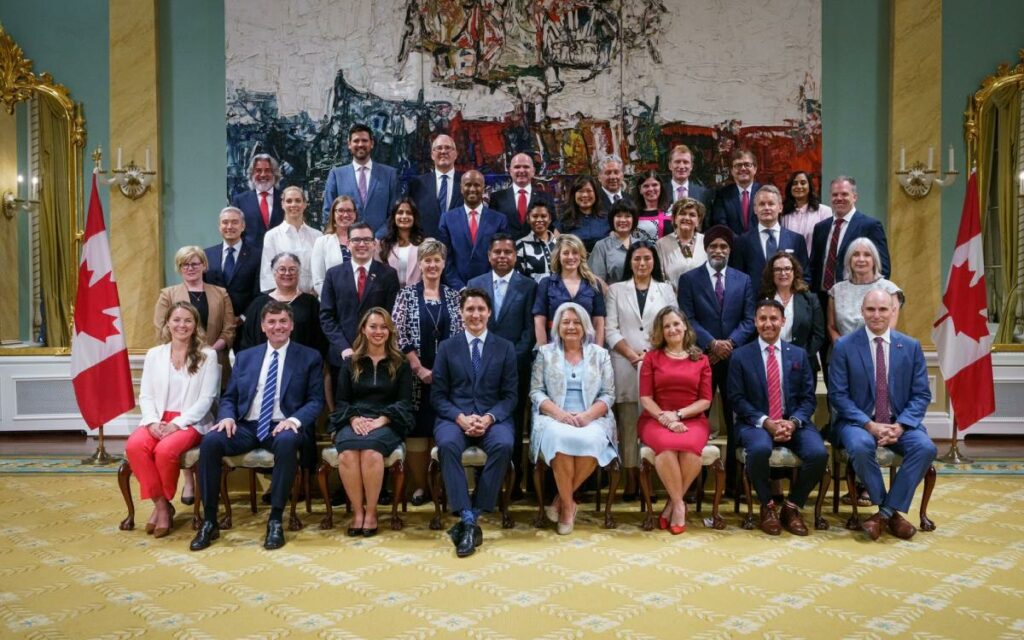
While the Prime Minister made a number of changes, finance, foreign affairs, industry, environment, and international trade remained in the hands of Trudeau’s band of untouchables, indicating no serious course correction at the top. Photo credit: Twitter/Justin Trudeau
The unveiling of Wednesday’s cabinet shuffle was somewhere between an episode of Game of Thrones and a late night rerun of Jeopardy. On first blush, it seemed as though a massive upheaval took place to elevate new faces and replace the old guard in an effort to hit reset and start anew.
But an early indication of the magnitude (or lack thereof) was when Chrystia Freeland, Francois-Philippe Champagne and Mary Ng flashed across the news screen, walking in unison towards the doors of Rideau Hall. Surely any serious reset would see a shift at the highest levels.
Lo and behold, and despite serious speculation in the weeks leading up to the shuffle, the top jobs were not up for grabs. Finance, foreign affairs, industry, environment, and international trade remained in the hands of Trudeau’s band of untouchables in a nod that there would be no serious course corrections ahead of the next federal election.
In total, eight ministers kept their positions, seven MPs new to cabinet were promoted, while 23 were shuffled. Perhaps reading the tea leaves, some ministers chose to use this opportunity to announce they wouldn’t be running again, while others like Marco Mendicino committed to giving the next election another go, despite his relegation to the government backbenches.
Perhaps the biggest surprise of the day was the move to oust Anita Anand from the defence file into a notably less high-profile position and replace her with Bill Blair. Given the severity of the war raging against Ukraine, and a recent commitment from NATO leaders to boost defence spending and make the two per cent of GDP target the minimum defence spend each year, it seemed that there was a desire for continuity at National Defence. Not the case.
Bill Blair recently drew criticism for his time at public safety and his handling of a CSIS briefing note containing details that MP Michael Chong and his family were a target of the communist regime. Blair claimed the note hadn’t reached him, and stated that he should have received other forms of communication from CSIS to alert him to the matter.
Now in charge of a massive defence budget, and with allies looking for Canada to start paying its fair share in the face of an ever-changing geopolitical climate, Blair and his staff will have to sharpen their issues management skills to avoid the pitfalls that plagued him in previous roles if he hopes to make it until the next election.
The stakes couldn’t be higher for the prime minister and his cabinet as they enter the mid-mandate period with eyes toward the next election.
While the bait-and-switch stunt of adding new faces to the front bench may create some buzz to get the Liberals a temporary bump in the polls, it may not be enough to solve their long-term fortunes. Worth noting is the fact that a similar strategy was deployed by the former Harper government in 2013 but did little to fix the reputational problems that had taken hold.
Time will tell if today’s shuffle serves as the reset the Liberals are hoping for, or leads to Trudeau sharing the same fate in the history books as his predecessor.

Josie Sabatino is a Senior Consultant at Summa Strategies, focused on providing strategic insight and helping clients meet their objectives in an ever changing and complex political and regulatory environment. Prior to joining Summa, Josie spent nearly a decade in political communications and most recently served as the Director of Communications to the Hon. Erin O’Toole, former Leader of the Official Opposition.






